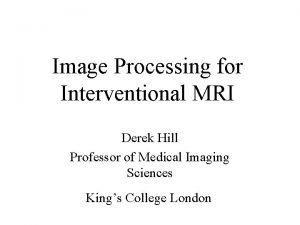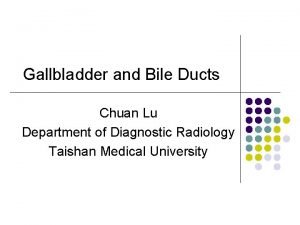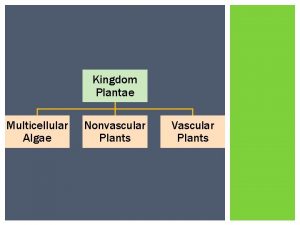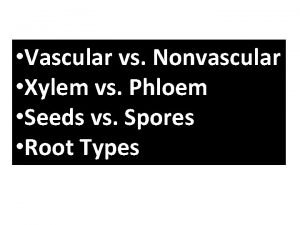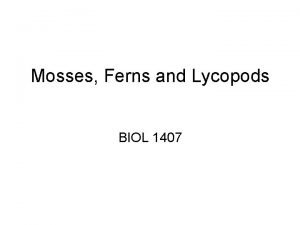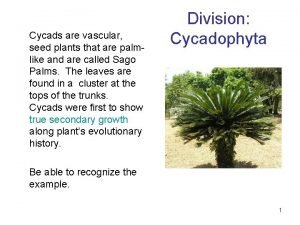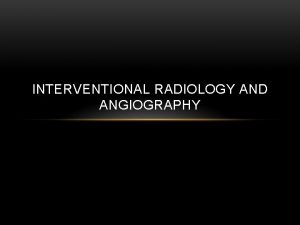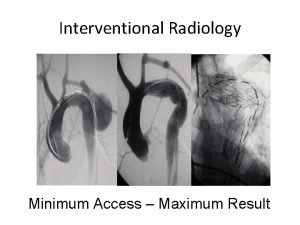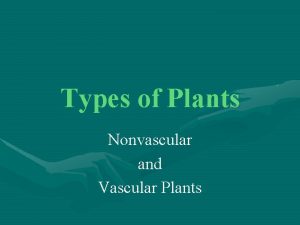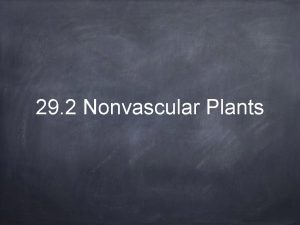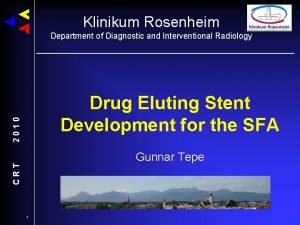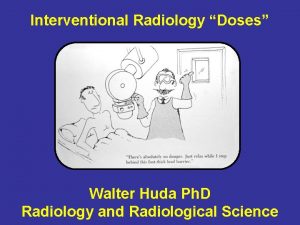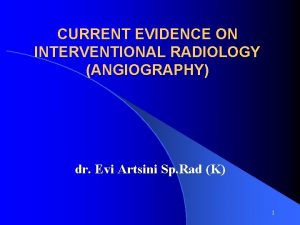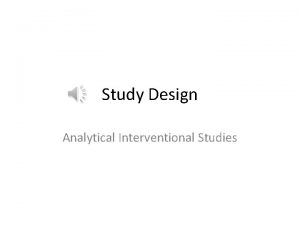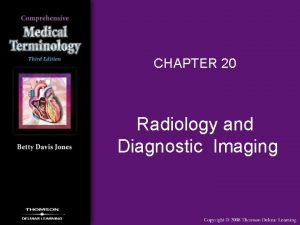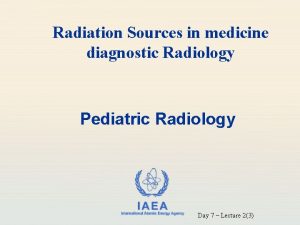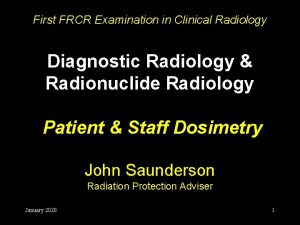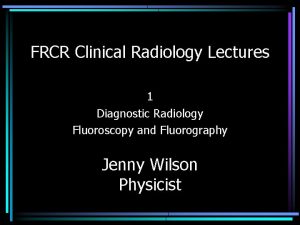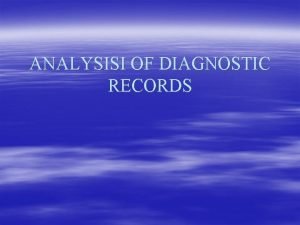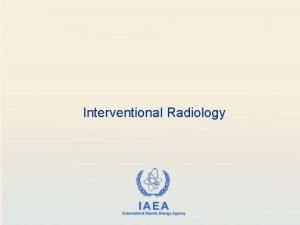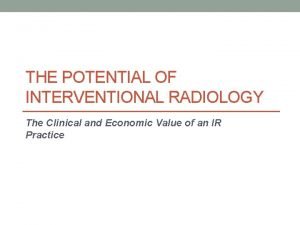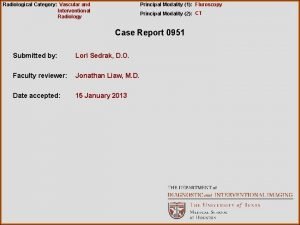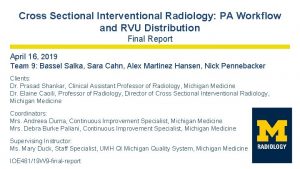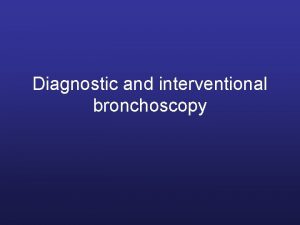Current Radiology diagnostic radiology interventional radiology nonvascular and































- Slides: 31

Current Radiology • diagnostic radiology • interventional radiology –nonvascular and vascular IR • background - imaging –diagnosis –imaging guided miniinvasive procedures • biopsies, fine needle aspirations • therapeutical procedures: drainages, angioplasty, stenting, thrombolysis

Wilhelm Conrad Roentgen Discovery of x-rays 8. 11. 1895

Imaging methods • conventional radiology • (digital) radiography, fluoroscopy • conventional tomography • • ultrasound (US, 2 D, Doppler) computed tomography (CT) magnetic resonance (MRI) angiography (DSA) • hybrid imaging (PET/CT, SPECT/CT) • (nuclear medicine imaging: planar, SPECT, PET)

Conventional radiology • Plain films (native) • contrast studies • barium studies GIT • double contrast: air+barium, enteroclysis: metylcelulosis+barium • iodinated CA: • • • intravenous pyelography (IVP) fistulography ERCP, PTC

Visualization of roentgen image • Fluoroscopy – image is generated on fluoroscopic screen (shield) - excitation – image is positive (bones are dark) • Radiography – record of image on film - photochemical reaction – image is negative (bones are light)

Categories of US imaging • morphological (2 D) – spectra – color coded (CDI) – power (CDE, CPA) triplex • Doppler duplex – B mode

What is 3 D and 4 D ultrasonography? 2 D 3 D 4 D

Advances in CT • spiral (helical) CT • - volumetric imaging • no gaps due to breathing • faster scanning, CTA feasibility • multidetector systems • HRCT - (lung, bones – petrous bone etc) • thin collimation of sections • high resolution image recostruction algorithm

Conventional x spiral CT inkrementální sken spirální sken

Postprocessing-2 D rekonstrukce MPR=multiplanární rekonstrukce sagitální MPR

MDCT – coronal sections

MDCT CTCA – 16 rows of detektorů J. Ferda, FN Plzeň - Lochotín

Example: Case 1 10. 3. 2000 31. 10. 2000


HRCT

CT 2. 11. 2000

CT, brain 3. 11. 2000 Autopsy: lung CA, carcinomatous lymphangiopathy, non-infectious (marantic) endocarditis, peripheral embolization

Contrast agents (substances) • Positive contrast = more absorbing substances (elements with high proton number Z) – barium - barium sulfate suspension (GIT) – iodine substances water soluble iodinated CA: angiocardiography, bronchography lipiodol: lymhography • Negative contrast = gases of low density – air, carbon dioxide, nitrogen (pneumoencephalography) • Double contrast = combination of both contrasts – gastrointestinal tract • • • CT - diluted barium (GIT), iodinated CM (GIT, i. v. ) MR - paramagnetic CM (gadolinium) US - microbubbles (work in progress)

Example: case 2

Diagnosis: non-occlusive mesenteric ischemia

Diagnostic algorithms Case 3: acute biliary pancreatitis Ultrasound 1. day: etiology

ERCP 1. day, papilotomy: treatment CT with CA, 4. day: staging AP

Clinical value of MRI • Commonest indications • neuroradiology – brain – spinal canal • • musculoskeletal system heart, vessels - MRA, abdomen, pelvis (prenatal MR) • advances • Faster acquisitions • MR angiography - TOF, PC, with contrast agent - gadolinium

Kongenitální PNET

Congenital PNET

Subarachnoid bleeding

CTA - MDCT

Saccular aneurysm on AB MPR MIP

MR of tle heart - cine mode

Trends in radiology: less radiation, less invasivity Typical field: angiography • Doppler ultrasonography • CT angiography • MR angiography

Enjoy your radiology lessons! (we will enjoy your exam)
 Types of interventional studies
Types of interventional studies Porofessor overlay
Porofessor overlay Gallbladder length
Gallbladder length Site:slidetodoc.com
Site:slidetodoc.com Fern kingdom
Fern kingdom Is seaweed vascular or nonvascular
Is seaweed vascular or nonvascular Line currents
Line currents Line vs phase voltage
Line vs phase voltage Energy band diagram of pnp transistor
Energy band diagram of pnp transistor Ac theory 3 lesson 4
Ac theory 3 lesson 4 Drift vs diffusion current
Drift vs diffusion current Drift current and diffusion current
Drift current and diffusion current Balanced delta delta connection
Balanced delta delta connection Infineon
Infineon Drift current density unit
Drift current density unit Seed vs spore
Seed vs spore Reproduce by spores
Reproduce by spores Vascular plants vs nonvascular plants
Vascular plants vs nonvascular plants Non vascular plant
Non vascular plant Characteristics of vascular plants
Characteristics of vascular plants Is a gerber daisy vascular or nonvascular
Is a gerber daisy vascular or nonvascular Coniferophyta vascular or nonvascular
Coniferophyta vascular or nonvascular Seedless vascular
Seedless vascular Nutritional habits for hypnum sp
Nutritional habits for hypnum sp Nonvascular seedless plants
Nonvascular seedless plants Common characteristics of plantae
Common characteristics of plantae Psilotum photosynthesis
Psilotum photosynthesis Are cycads vascular or nonvascular
Are cycads vascular or nonvascular Gm formula for mosfet
Gm formula for mosfet All of the heat produced by sma weld stays in the weld.
All of the heat produced by sma weld stays in the weld. Touch current vs leakage current
Touch current vs leakage current Non planar circuit
Non planar circuit

